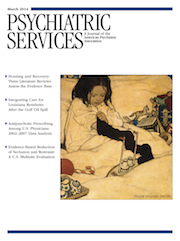Changes in Physician Antipsychotic Prescribing Preferences, 2002–2007
Abstract
Objective
Physician antipsychotic prescribing behavior may be influenced by comparative effectiveness evidence, regulatory warnings, and formulary and other restrictions on these drugs. This study measured changes in the degree to which physicians are able to customize treatment choices and changes in physician preferences for specific agents after these events.
Methods
The study used 2002–2007 prescribing data from the IMS Health Xponent database and data on physician characteristics from the American Medical Association for a longitudinal cohort of 7,399 physicians. Descriptive and multivariable regression analyses were conducted of the concentration of prescribing (physician-level Herfindahl index) and preferences for and likelihood of prescribing two first-generation antipsychotics and six second-generation antipsychotics. Analyses adjusted for prescribing volume, specialty, demographic characteristics, practice setting, and education.
Results
Antipsychotic prescribing was highly concentrated at the physician level, with a mean unadjusted Herfindahl index of .33 in 2002 and .29 in 2007. Psychiatrists reduced the concentration of their prescribing more over time than did other physicians. High-volume psychiatrists had a Herfindahl index that was half that of low-volume physicians in other specialties (.18 versus .36), a difference that remained significant (p<.001) after adjustment for physician characteristics. The share of physicians preferring olanzapine dropped from 29.9% in 2002 to 10.3% in 2007 (p<.001) while the share favoring quetiapine increased from 9.4% to 44.5% (p<.001). Few physicians (<5%) preferred a first-generation antipsychotic in 2002 or 2007.
Conclusions
Preferences for specific antipsychotics changed dramatically during this period. Although physician prescribing remained heavily concentrated, the concentration decreased over time, particularly among psychiatrists.



